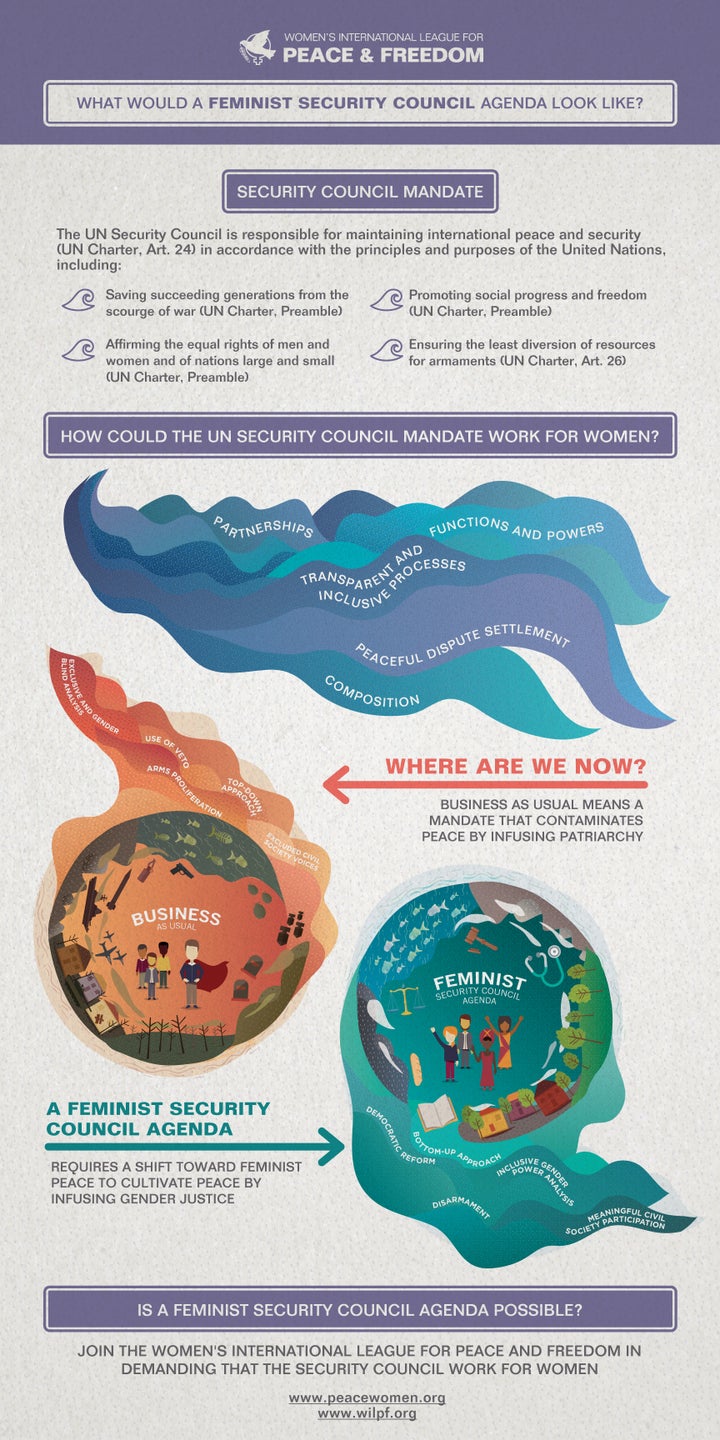Lets start with a new vision, and an optimistic premise that the Security Council and ‘we the people of the United Nations’ are actually on the same side: that we all want sustainable peace and security. A world where all people, no matter who they are, can thrive.
This would mean the Security Council listens and uses information so as to better understand the root causes of conflict, the possibilities for change, and the policies needed to achieve it. Communities affected by conflict and local women can give real input, analysis and information and be connected so actions are responsive to the diverse needs, rights, and requirements of the people.
It would be a radically different UN Security Council. A Council which would in effect be an agenda infused with feminism. It would focus on civilians and disarmament, on women and girls as agents and participants. Activists facing increasing attacks and shrinking spaces that curb their voices, expertise, and rights would get protection. Military budgets would decrease. Livelihoods and social and economic rights would be actually funded. Women civil society would be valued and invested in.
Alas, today, not only does the Security Council fail this vision of transformative international action, but this UN body entrusted with maintaining international peace and security, is failing to uphold the minimum of its mandate.
Is it, in fact, doing more harm than good? A combination of geo-political struggles, economic interests, and the continuing power of the five permanent members and their veto, all reflect the patriarchal hierachy of the UN and its absolute failure to reflect current changes in thinking, and current social, legal and scientific advances: by any objective standards, it is failing in its mandate!
The members of the Security Council continue to do business as usual. Despite the changing nature of the ‘threats’ they are charged to deal with, and despite the changes that have been made to the international legal framework in which they operate, Today’s context is very different from that of 1945, there has been progress in many areas in large part by broad combination of civil society, activists, sensible States, and reasoned legal argument.
From the progressive development of Human Rights Law, to the creation of the International Criminal Court (ICC) and the Women, Peace and Security (WPS) agenda within the system itself, there is a body of international law that would enable rational argument to replace violence as a means of dispute resolution. Throw in the enormous potential of using the Bretton Woods organisations to support human rights obligations, and reframing the debate on peace and security would be entirely possible.
Most of us know what is wrong with a system which is dictated by five States. The use of veto prolongs conflict and instability. All the permanent members have vested political and economic interests in many the situations of concern. For example, the Permanent Five are making billions of dollars from the total destruction of Yemen – violating the intent of Article 26 of the UN Charter. This makes resolving that conflict within the Council all but impossible.
The narrow focus in the Council, which is overtly political, is not only mistaken but also fails to look at examples of cooperation between States that are considered to be antagonistic, but which actually show results. Take as an example the excellent collaboration between the EU and Russia on the European Sentinel satellite which is dedicated to environmental analysis, inter alia, so that joint actions can be taken to address harmful emissions. The latest satellite went into orbit last week after taking off from Russia. Cooperation is possible if there is the will to do so.
The two governments which embrace feminism (at least to some extent!) are pushing on certain issues. Sweden has lead the way and leveraged its position on the Council to address gender and include women civil society in its work. Canada is now building momentum through exploring “feminist aid.” Much remains to be done. But member states which are seriously engaging on gender are starting the conversation about what is possible.
The peace process in Colombia has demonstrated that change is possible. It has shown significant “good practice” in bringing local women and civil society to the table and including women’s rights issues in the Peace Agreement between the Colombian Government and the guerrilla group FARC-EP. We all know that peace is not only the agreement itself but a process. This is just one step. But the Colombian case shows the start of a different way – one that starts with local women’s voices and analysis of gender and how power is its product.
Can the Security Council work for women? Not with its current polluted streams of work. But with prevention as the UN Secretary General’s number one priority and governments protesting their feminism: now is the time to find out what is possible.

What would a Feminist Security Council Agenda look like? WILPF asks this question in its latest infograph.
Read: WILPF’s new “Feminist Security Council Agenda” infographic and “Security Council Scorecard on Women, Peace and Security: Lessons Learned from 2010-2016” research brief (released October 2017)
See also:
http://wilpf.org/
http://peacewomen.org/
